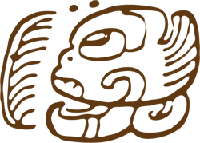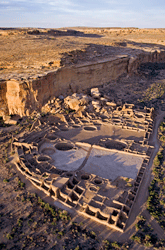
Tracking the chemical signature of cacao across Mesoamerica
 |
A Late Classic (A.D. 600–800) vase depicts a Maya lord being presented with a bowl of frothing cacao, or chocolate. (© Justin Kerr)

The glyph, second from the bottom on the far right column, is the sign for cacao. |
When the Spaniards first arrived at the Aztec capital of Tenochtitlan in 1519, among the lavish spectacles they witnessed was King Moctezuma being served more than 50 jars of foaming chocolatl. This drink, made from the seeds of the cacao tree (Theobroma cacao), was the precursor to what we now know as chocolate. Chronicler Bernal Díaz del Castillo, who left behind the most extensive record of the Spanish conquest, noted that the Aztecs said the cacao beverage was for "success with women," suggesting the link between chocolate and romance is ancient. Studies, in fact, show that a compound found in chocolate, phenylethylamine, is the same chemical the brain releases when a person experiences attraction.
 In the 1920s, cylinder vessels similar to those used in Mesoamerica to hold chocolate beverages were discovered at Pueblo Bonito (860–1128), the largest multistory masonry complex, or "Great House," at New Mexico's Chaco Canyon. (Courtesy Patricia Crown, from the collections of the American Museum of Natural History, photograph by Marianne Tyndall) |
 (Scott Haefner) |
But for the Aztecs, the drink was much more than an aphrodisiac. Cacao was central to their concept of political power and played a role in rituals of all sorts, including funerals and marriage celebrations. A 1545 document written in Nahuatl, the language of the Aztecs and other Central Mexican peoples, shows that cacao was even used as currency—a turkey was worth 200 cacao seeds, a tamale was worth one, and the daily wage of a porter at the time was 100 cacao seeds.
Despite its economic and cultural importance in pre-Columbian Mesoamerica, archaeologists have until recently had only a hazy understanding of cacao's history. But within the past decade, detective work on dirty clay pots by chemists at the labs of the Hershey Company, the largest producer of chocolate in the U.S., has pushed back the antiquity of cacao beverages by 2,000 years to at least 1500 B.C., if not earlier. Understanding the early history of chocolate has led archaeologists to speculate that cacao played a critical role in the economic, religious, and political development of people such as the Olmec, Maya, and ultimately even the Anasazi, or Ancestral Puebloan peoples of the American Southwest.
Blake Edgar is a senior editor at the University of California Press and a contributing editor to ARCHAEOLOGY.
Advertisement

Advertisement







